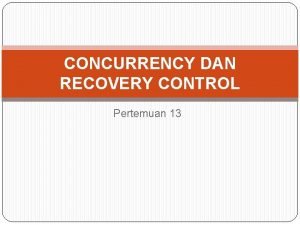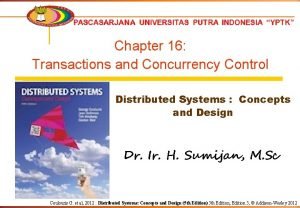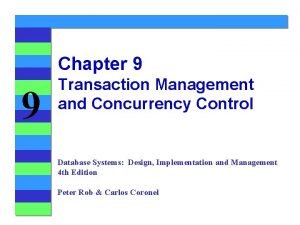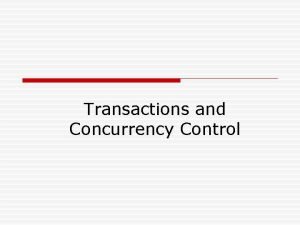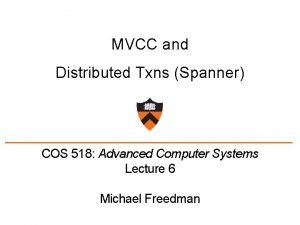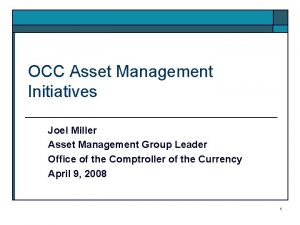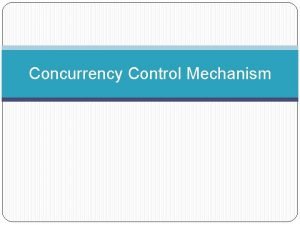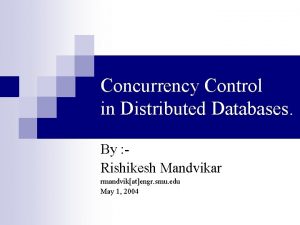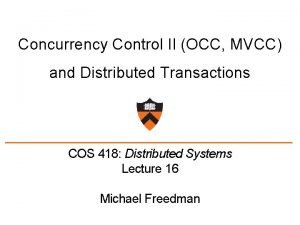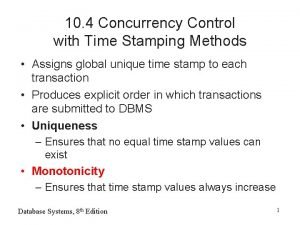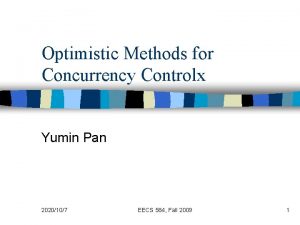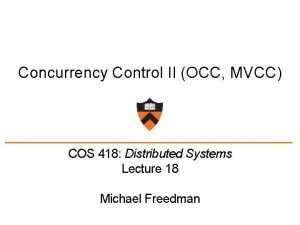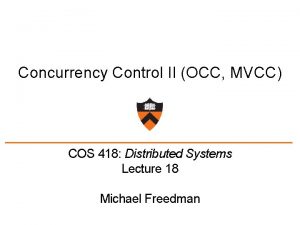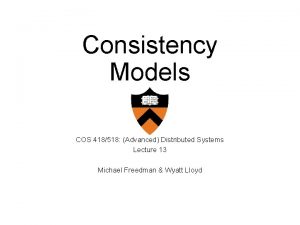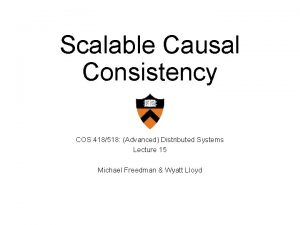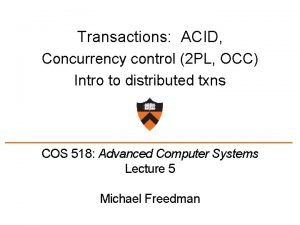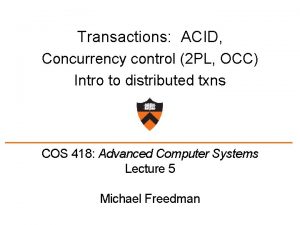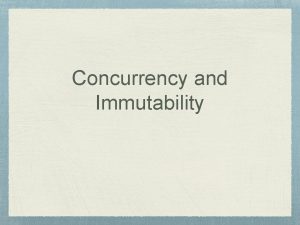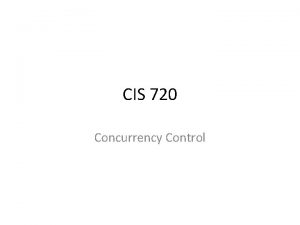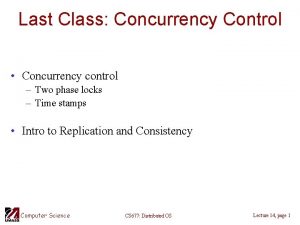Concurrency control OCC and MVCC COS 418518 Lecture

























- Slides: 25

Concurrency control (OCC and MVCC) COS 418/518 Lecture 16 Michael Freedman & Wyatt Lloyd

Serializability Execution of a set of transactions over multiple items is equivalent to some serial execution of txns 2

Lock-based concurrency control • Big Global Lock: Results in a serial transaction schedule at the cost of performance • Two-phase locking with finer-grain locks: – Growing phase when txn acquires locks – Shrinking phase when txn releases locks (typically commit) – Allows txn to execute concurrently, improving performance 3

Q: What if access patterns rarely, if ever, conflict? 4

Be optimistic! • Goal: Low overhead for non-conflicting txns • Assume success! – Process transaction as if would succeed – Check for serializability only at commit time – If fails, abort transaction • Optimistic Concurrency Control (OCC) – Higher performance when few conflicts vs. locking – Lower performance when many conflicts vs. locking 5

2 PL vs OCC • From ”Rococo” paper in OSDI 2014. Focus on 2 PL vs. OCC. • Observe OCC better when write rate lower (fewer conflicts), worse than 2 PL with write rate higher (more conflicts) 6

OCC: Three-phase approach • Begin: Record timestamp marking the transaction’s beginning • Modify phase: – Txn can read values of committed data items – Updates only to local copies (versions) of items (in db cache) • Validate phase • Commit phase – If validates, transaction’s updates applied to DB – Otherwise, transaction restarted – Care must be taken to avoid “TOCTTOU” issues 7

OCC: Why validation is necessary txn coord When commits txn updates, create new versions at some timestamp t O • New txn creates shadow copies of P and Q • P and Q’s copies at inconsistent state P txn coord Q 8

OCC: Validate Phase • Transaction is about to commit. System must ensure: – Initial consistency: Versions of accessed objects at start consistent – No conflicting concurrency: No other txn has committed an operation at object that conflicts with one of this txn’s invocations 9

OCC: Validate Phase • Validation needed by transaction T to commit: • For all other txns O either committed or in validation phase, one of following holds: A. O completes commit before T starts modify B. T starts commit after O completes commit, Read. Set T and Write. Set O are disjoint and C. Both Read. Set T and Write. Set T are disjoint from Write. Set O, and O completes modify phase. • When validating T, first check (A), then (B), then (C). If all fail, validation fails and T aborted 10

2 PL & OCC = strict serialization • Provides semantics as if only one transaction was running on DB at time, in serial order + Real-time guarantees • 2 PL: Pessimistically get all the locks first • OCC: Optimistically create copies, but then recheck all read + written items before commit 11

Multi-version concurrency control Generalize use of multiple versions of objects 12

Multi-version concurrency control • Maintain multiple versions of objects, each with own timestamp. Allocate correct version to reads. • Prior example of MVCC: 13

Multi-version concurrency control • Maintain multiple versions of objects, each with own timestamp. Allocate correct version to reads. • Unlike 2 PL/OCC, reads never rejected • Occasionally run garbage collection to clean up 14

MVCC Intuition • Split transaction into read set and write set – All reads execute as if one “snapshot” – All writes execute as if one later “snapshot” • Yields snapshot isolation < serializability 15

Timestamps in MVCC • Transactions are assigned timestamps, which may get assigned to objects those txns read/write • Every object version OV has both read and write TS – Read. TS: Largest timestamp of txn that reads OV – Write. TS: Timestamp of txn that wrote OV 16

Executing transaction T in MVCC • Find version of object O to read: – – # Determine the last version written before read snapshot time Find OV s. t. max { Write. TS(OV) | Write. TS(OV) <= TS(T) } Read. TS(OV) = max(TS(T), Read. TS(OV)) Return OV to T • Perform write of object O or abort if conflicting: – Find OV s. t. max { Write. TS(OV) | Write. TS(OV) <= TS(T) } – # Abort if another T’ exists and has read O after T – If Read. TS(OV) > TS(T) • Abort and roll-back T – Else • Create new version OW • Set Read. TS(OW) = Write. TS(OW) = TS(T) 17

Digging deeper Notation txn txn TS = 3 TS = 4 TS = 5 W(1) = 3: Write creates version 1 with Write. TS = 3 R(1) = 3: Read of version 1 returns timestamp 3 write(O) by TS=3 O 18

Digging deeper Notation W(1) = 3: Write creates version 1 with Write. TS = 3 txn txn TS = 3 TS = 4 TS = 5 W(1) = 3 R(1) = 3: Read of version 1 returns timestamp 3 write(O) by TS=5 O 19

Digging deeper Notation W(1) = 3: Write creates version 1 with Write. TS = 3 txn txn TS = 3 TS = 4 TS = 5 W(1) = 3 R(1) = 3: Read of version 1 returns timestamp 3 W(2) = 5 R(2) = 5 O write(O) by TS = 4 Find v such that max Write. TS(v) <= (TS = 4) Þ v = 1 has (Write. TS = 3) <= 4 If Read. TS(1) > 4, abort Þ 3 > 4: false Otherwise, write object 20

Digging deeper Notation W(1) = 3: Write creates version 1 with Write. TS = 3 txn txn TS = 3 TS = 4 TS = 5 W(1) = 3 R(1) = 3 W(3) = 4 R(1) = 3: Read of version 1 returns timestamp 3 W(2) = 5 R(2) = 5 O Find v such that max Write. TS(v) <= (TS = 4) Þ v = 1 has (Write. TS = 3) <= 4 If Read. TS(1) > 4, abort Þ 3 > 4: false Otherwise, write object 21

Digging deeper Notation txn txn TS = 3 TS = 4 TS = 5 W(1) = 3: Write creates version 1 with Write. TS = 3 R(1) = 3: Read of version 1 returns timestamp 3 W(1) = 3 3 R(1) = 5 O BEGIN Transaction tmp = READ(O) WRITE (O, tmp + 1) END Transaction Find v such that max Write. TS(v) <= (TS = 5) Þ v = 1 has (Write. TS = 3) <= 5 Set R(1) = max(5, R(1)) = 5 22

Digging deeper Notation W(1) = 3: Write creates version 1 with Write. TS = 3 txn txn TS = 3 TS = 4 TS = 5 W(1) = 3 3 R(1) = 5 R(1) = 3: Read of version 1 returns timestamp 3 W(2) = 5 R(2) = 5 O BEGIN Transaction tmp = READ(O) WRITE (O, tmp + 1) END Transaction Find v such that max Write. TS(v) <= (TS = 5) Þ v = 1 has (Write. TS = 3) <= 5 If Read. TS(1) > 5, abort Þ 5 > 5: false Otherwise, write object 23

Digging deeper Notation W(1) = 3: Write creates version 1 with Write. TS = 3 txn txn TS = 3 TS = 4 TS = 5 W(1) = 3 3 R(1) = 5 R(1) = 3: Read of version 1 returns timestamp 3 W(2) = 5 R(2) = 5 O write(O) by TS = 4 Find v such that max Write. TS(v) <= (TS = 4) Þ v = 1 has (Write. TS = 3) <= 4 If Read. TS(1) > 4, abort Þ 5 > 4: true 24

Digging deeper Notation W(1) = 3: Write creates version 1 with Write. TS = 3 txn txn TS = 3 TS = 4 TS = 5 W(1) = 3 3 R(1) = 5 R(1) = 3: Read of version 1 returns timestamp 3 W(2) = 5 R(2) = 5 O BEGIN Transaction tmp = READ(O) WRITE (P, tmp + 1) END Transaction Find v such that max Write. TS(v) <= (TS = 4) Þ v = 1 has (Write. TS = 3) <= 4 Set R(1) = max(4, R(1)) = 5 Then write on P succeeds as well 25
 Tarpit java
Tarpit java Concurrency control and recovery in database systems
Concurrency control and recovery in database systems Recovery control
Recovery control Transactions and concurrency control in distributed systems
Transactions and concurrency control in distributed systems Transaction management in dbms
Transaction management in dbms Example of concurrency control in dbms
Example of concurrency control in dbms Transaction management and concurrency control
Transaction management and concurrency control Occ.edready
Occ.edready Occ bulletin 2007-21
Occ bulletin 2007-21 Occ new student orientation
Occ new student orientation Occ systems
Occ systems Modelo occ
Modelo occ Occ contador
Occ contador Occ bulletin 2017 43
Occ bulletin 2017 43 Occ investment management handbook
Occ investment management handbook Pitfalls of lock based protocol
Pitfalls of lock based protocol Concurrency control in distributed databases
Concurrency control in distributed databases Timemasters locks
Timemasters locks Concurrency stamp
Concurrency stamp Microsoft flow concurrency control
Microsoft flow concurrency control Timestamp based concurrency control
Timestamp based concurrency control On optimistic methods for concurrency control
On optimistic methods for concurrency control 01:640:244 lecture notes - lecture 15: plat, idah, farad
01:640:244 lecture notes - lecture 15: plat, idah, farad Diketahui sin a = 0,6
Diketahui sin a = 0,6 Cos c -cos d
Cos c -cos d Bentuk sederhana dari sin 160 + sin 40 adalah
Bentuk sederhana dari sin 160 + sin 40 adalah


